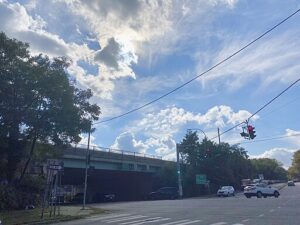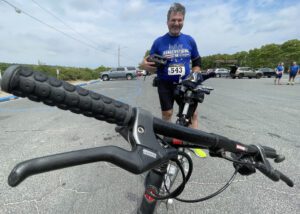Advocates are fighting for safer, more walkable roads for Long Island
By Gabrielle Yanovitz
Editor’s note: The following is part one of a multi-part series on Long Island road safety.
Hofstra University student Jay Learson was skateboarding across California Avenue in Uniondale after class on an October afternoon in 2021. Isabella Procida was crossing Main Street in Farmingdale on her way home after a rehearsal in mid-August 2019. Neither was prepared for the alarming events that would ensue. Before they knew it, their hearts would skip a beat as they would become two more pedestrians to be hit by a vehicle.
“No one really prepares you for what to do in a situation like that,” said Procida, who is now a 20-year-old student at SUNY Old Westbury. “I was pretty scared…I didn’t know how to handle myself.” She was 15 at the time of the accident, and never found the driver who struck her.
Neither Learson nor Procida suffered injuries from their accidents, minus a few scrapes and bruises. Their stories, however, are a cautionary tale and reflect the rising number of pedestrian-related accidents and fatalities on Long Island in recent years.
In Nassau County alone, there were 485 pedestrian accidents in 2023, 17 of them fatal, according to Nassau County Police Department data obtained through a Freedom of Information request. This was a 16% increase in accidents from 2022, which saw 418 pedestrian accidents, 15 of them fatal.
Across Long Island, there has been an uptick in pedestrian deaths over the last five years, with more than 55 pedestrians killed per year since 2019.

Eric Alexander, the director of the nonprofit Vision Long Island, said state and county roads are among the most dangerous on the Island. These include thoroughfares such as Hempstead Turnpike (Route 24), Jericho Turnpike (Route 25), Sunrise Highway (Route 27) and Merrick Road, among others.
“We have dangerously designed roads, and pedestrians and bicyclists are seen as an afterthought,” Alexander said. “They’re designed by folks who have historically prioritized automobile speed over pedestrian and bicycle safety.”
He named two primary solutions to solving this issue — either increasing the use of speed cameras and ticketing to enforce the speed limits, or designing the roads differently to prevent speeding. He prefers the latter as the most effective method, citing “traffic-calming solutions” as the means to improve road safety.
Alexander listed several features that can be implemented on roads to increase safety for pedestrians, including narrower lanes, medians, wide and well-lit crosswalks, protected sidewalks, bulb outs and functioning countdown timers.
“All of these things are pretty cheap…Some of this stuff is just paint,” he said. “There’s no reason why these things can’t be employed.”
Dozens of communities across Long Island have put traffic-calming solutions into effect on their local roads. Christopher Gosley, a legislative assistant for Assemblywoman Michaelle Solages of District 22, shared in an interview that their team has made it a priority to improve conditions of roads so they are more walkable. He referenced efforts that officials within the district have made to reinforce crosswalks on Central Avenue in Valley Stream, where the district office is located.
Gosley also noted that the Village of Valley Stream is actively working to lower the local speed limit from 30 mph to 25 mph. This process follows the recent passage of Sammy’s Law. In the wake of “traffic violence” in New York City, the law authorizes city officials to reduce traffic speeds from 25 to 20 mph, and from 15 to 10 mph in special “traffic-calming” zones, also known as “slow zones.”
“All of these things are pretty cheap…Some of this stuff is just paint. There’s no reason why these things can’t be employed.”
Eric Alexander, Vision Long Island
The ongoing challenge, however, is undertaking projects on the county and state roads that are becoming increasingly dense with pedestrians. These roads are not only the most dangerous, but also have proven to be the most difficult to change.
“The larger the government entity that manages the road, the worse the road is,” said Alexander, noting a disconnect between the New York State Department of Transportation and the Long Island public.
Although he praised the NYSDOT for actively installing countdown timers and laying down fresh coats of crosswalk paint on state roads, implementing projects like lane narrowing seem less likely.
Other organizations across Long Island propose alternative solutions to improving pedestrian safety that do not involve the redesigning of roads. The New York Coalition for Transportation Safety, a non-profit based in Westbury, focuses on education and outreach initiatives to encourage pedestrian safety.
“We go into schools, senior centers, churches…trying to get the message out and teach people to be visible, to be careful, and to stop walking in front of traffic or behind cars,” said Cynthia Brown, the NYCTS director.
Both Alexander and Brown spoke of Hempstead Turnpike as one of the most dangerous roads for pedestrians on Long Island. Brown, calling it the “road of death,” said there are a greater number of people without vehicles in the Village of Hempstead, forced to walk along and across the turnpike with cars driving in some areas at speeds up to 55 mph.
In 2023, there were 48 pedestrian traffic incidents on Hempstead Turnpike alone, according to data from the Nassau County Police Department Traffic Safety Unit.
Brown additionally described the harsh conditions for pedestrians in the Village of Hempstead as a whole, citing where Glen Cove Road transitions into Clinton Road as one travels south. “You go from Garden City that has all the bells and whistles and fancy stop signs to a low-income area with nothing,” she said.
Brown also named electric scooters to be a growing problem that is contributing to pedestrian-related traffic incidents in western Long Island. “There are virtually no laws governing their operation,” she said. “There’s nothing that says you have to wear a helmet…They don’t have to be registered.”









